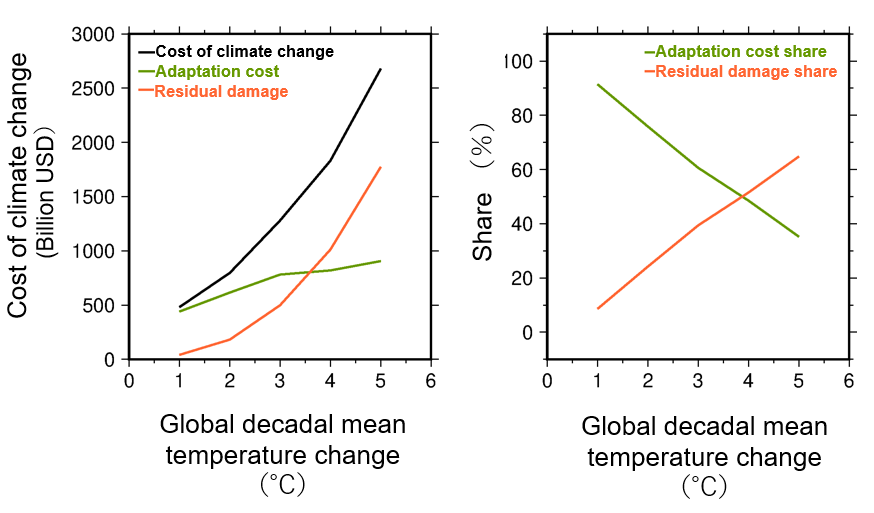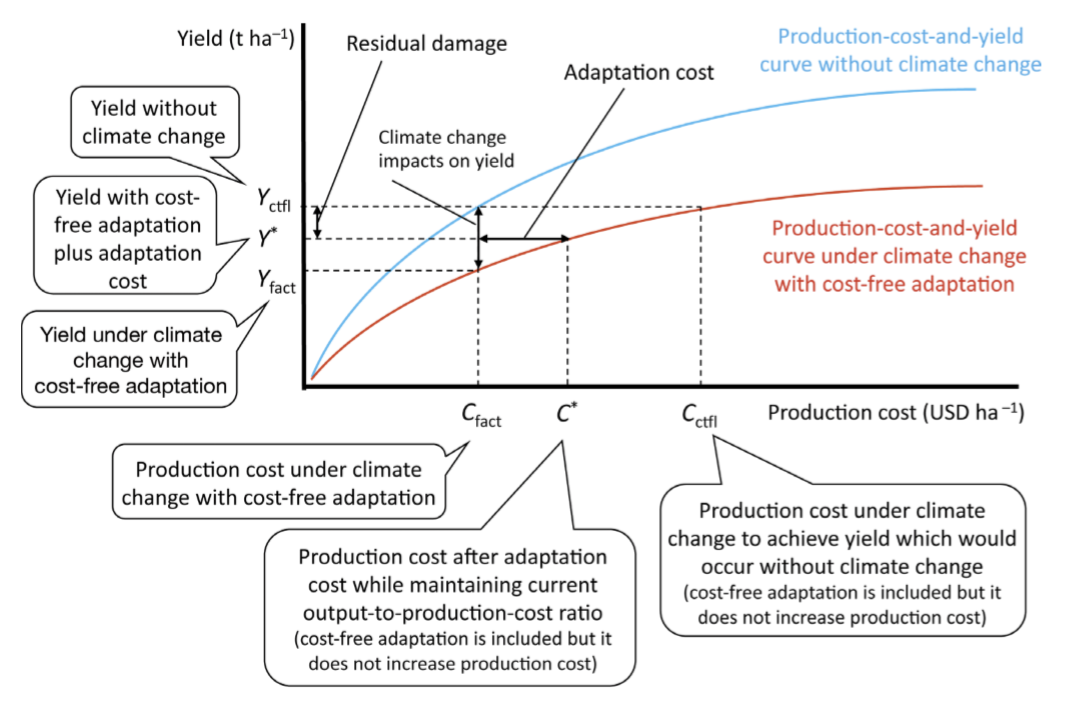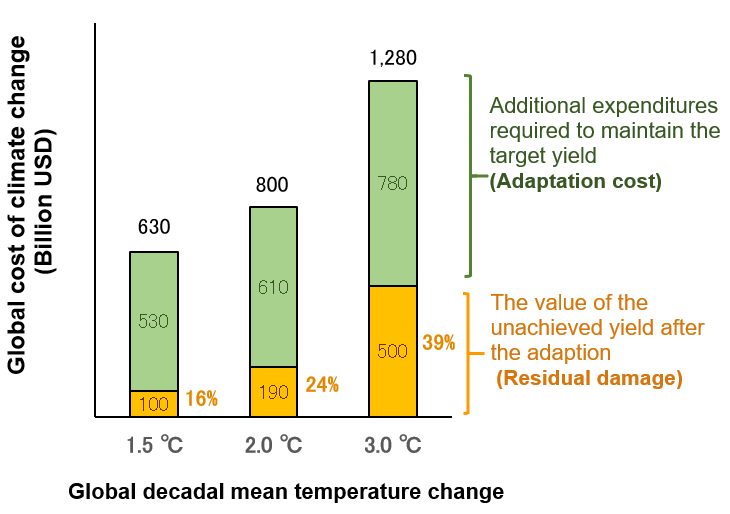The National Agriculture and Food Research Organization (NARO) in collaboration with the Japan International Research Center for Agricultural Sciences (JIRCAS) and the Policy Research Institute, Ministry of Agriculture, Forestry and Fisheries (PRIMAFF) has estimated the adaptation cost and residual damage for global production of four major crops, using a global gridded crop model and empirical production cost models. The simulation shows that a 2 ̊C increase in the global decadal mean temperature will cause adaptation cost of $61 billion (B) and residual damage of $19 B. Further climate change will drastically increase both figures, in particular the residual damage which will increase at a higher rate. The study reveals the limits of producer's private adaptation using incremental approach and offers the basis for policy makers to plan international financing for adaptation and agricultural development.
Overview
NARO, JIRCAS and PRIMAFF joint research team has projected the adaptation cost for, and residual damage to, the global crop production under projected climate change. Production of four major crops - maize, rice, wheat, and soybean - over 52 countries across the world was considered.
The adaptation considered in the study refers to the private adaptation by producers through additional expenditure for increases in fertilizer, water, chemicals, fuel, labor, machinery and equipment use to maintain the same yield that would be achieved without climate change. (In the study, agronomic adjustments such as sowing date shifts and cultivar switching are already implemented as cost-free adaptation.) Residual damage is the monetary value of the unavoidable production loss under climate change due to the biological limits of crops which cannot be prevented even with the adaptation.
The global cost of climate change (the adaptation cost plus residual damage) on these crops are projected to increase with warming from $63 B at 1.5 ̊C to $80 B at 2 ̊C and to $128 B at 3 ̊C per year with increased share of residual damage (the temperature changes are warming level relative to the pre-industrial level). Once the expenditures on adaptation become difficult for producers to maintain because of the negative impacts of climate change, biological limits of crops or profitability, producers will not be able to bear the adaptation costs, and the global annual residual damage will start to increase from $10 B at 1.5 ̊C to $19 B at 2 ̊C and to $50 B at 3 ̊C per year, with an escalating rate. The high level of residual damage suggests that incremental approach is insufficient to adapt to climate change, and more transformative approach is necessary. The study offers the basis for policy makers for planning international adaptation financing and agricultural development.
The research paper was published online on July 2, 2020 in the international science journal, Climate Research.
Publications
Toshichika Iizumi, Zhihong Shen, Jun Furuya, Tatsuji Koizumi, Gen Furuhashi, Wonsik Kim, Motoki Nishimori (2020) Climate change adaptation cost and residual damage to global crop production. Climate Research, 80, 203-218.https://doi.org/10.3354/cr01605
Related Studies
Global scale estimation of crop production loss due to global warming (Press Release, 2018)
Stagnation of crop yields in response to climate change (Press Release, 2017)
For Inquiries
Contact: http://www.naro.affrc.go.jp/english/inquiry/index.html
Reference Information

Fig.1 Cost of climate change, adaptation cost share and residual cost share
Left panel shows projected decadal mean global cost of climate change. Right panel shows the share of the adaptation cost and residual damage for the crops as a function of the global decadal mean temperature change relative to preindustrial level (1850 - 1900). Lines in both panels shows the average of calculations from 2,000 scenarios (4 emissions scenarios × 5 climate models × 5 socioeconomic scenarios × 2 production cost models [cross-sectional and panel specifications] × 10 decades for the 2001−2100 period), with the 1 ̊C bins starting at 0.5 ̊C.

Fig. 2 Production cost, decadal mean yield, adaptation cost and residual damage
The red curve represents the relationship between production cost and yield under climate change with cost-free adaptation such as sowing date shifts and cultivar switching. The blue curve represents the relationship between production cost and yield without climate change. The production cost and yield curves shown here are computed for each country and each crop by using a crop model, production cost models and other inputs. We assume yield increases with an increase in production costs and then levels off in both scenarios.
Given a production cost (Cfact), yield under climate change (Yfact) will be lower than yield without climate change (Yctfl). Here, the target yield under climate change conditions is Yctfl. With the additional expenditures by producers (increasing production cost to C*), the yield increases up to Y* where the adaptation cost no longer increase yield due to the biological limits of the crops or profitability, and the difference between Yctfl-Y* represents a residual damage in t ha ̅1. The country annual residual damage in US$ is calculated by multiplying the residual damage in t ha ̅1, the country average producer price (US$ t ̅1), and the country area harvested (ha).

Fig.3 The global cost of climate change in different scenarios and its breakdown into the adaptation cost and residual damage.
The sum of the adaptation cost and residual damage is the global cost of climate change. Figures on the top of each bar are the global cost of climate change (US$ Billion) for each warming level. Figures within green or orange areas are the values of adaptation cost and residual damage (US$ Billion), respectively.




